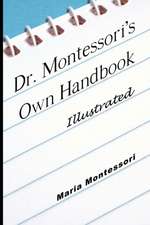The Montessori Method
Autor Maria Montessorien Limba Engleză Paperback – 19 noi 2009
Preț: 121.56 lei
Nou
Puncte Express: 182
Preț estimativ în valută:
23.26€ • 24.20$ • 19.21£
23.26€ • 24.20$ • 19.21£
Carte disponibilă
Livrare economică 22 martie-05 aprilie
Preluare comenzi: 021 569.72.76
Specificații
ISBN-13: 9781607961697
ISBN-10: 1607961695
Pagini: 244
Dimensiuni: 189 x 246 x 13 mm
Greutate: 0.45 kg
Editura: www.snowballpublishing.com
ISBN-10: 1607961695
Pagini: 244
Dimensiuni: 189 x 246 x 13 mm
Greutate: 0.45 kg
Editura: www.snowballpublishing.com
Descriere
This groundbreaking classic of educational philosophy takes on urgent new necessity today, as "traditional" methods of early-childhood schooling seem to be failing us. Published in Italian in 1909 and first translated into English in 1912, these still-revolutionary theories focus on the individuality of the child and on nurturing her inherent joy of learning to create schools and other learning environments that are oriented on the child. Eschewing rote memorization and drilling, Montessori's method helps to foster abstract thinking and to fulfill a child's highest potential, emotionally, physically and intellectually. Parents from all walks of life will find the ideas herein immensely valuable. Italian doctor and educator MARIA MONTESSORI (1870-1952) was the first woman to graduate from the University of Rome Medical School. She traveled extensively in Europe, America, and the Near East, studying early education and testing her educational methods.
Notă biografică
Maria Montessori (1870-1952) was an Italian educator and physician. Born in Chiaravalle, she came from a prominent, well-educated family of scientists and government officials. Raised in Florence and Rome, Montessori excelled in school from a young age, graduating from technical school in 1886. In 1890, she completed her degree in physics and mathematics, yet decided to pursue medicine rather than a career in engineering. At the University of Rome, she overcame prejudice from the predominately male faculty and student body, winning academic prizes and focusing her studies on pediatric medicine and psychiatry. She graduated in 1896 as a doctor in medicine and began working with mentally disabled children, for whom she also became a prominent public advocate. In 1901, she left her private practice to reenroll at the University of Rome for a degree in philosophy, dedicating herself to the study of scientific pedagogy and lecturing on the topic from 1904 to 1908. In 1906, she opened her Casa dei Bambini, a school for children from low-income families. As word of her endeavor spread, schools using the Montessori educational method began opening around the world. In the United States, the publication of The Montessori Method (1912) in English and her 1913 lecture tour fostered a rapid increase of Montessori schools in the country. For her groundbreaking status as one of Italy¿s first female public intellectuals and her role in developing a more individualized, psychologically informed approach to education, Maria Montessori continues to be recognized as one of the twentieth century¿s most influential figures.
Cuprins
INTRODUCTION TO THE TRANSACTION EDITION, INTRODUCTION. CHAPTER I A CRITICAL CONSIDERATION OF THE NEW PEDAGOGY IN ITS RELATION TO MODERN SCIENCE, CHAPTER II HISTORY OF METHODS, CHAPTER III INAUGURAL ADDRESS DELIVERED ON THE OCCASION OF THE OPENING OF ONE OF THE CHILDREN'S HOUSES, CHAPTER IV PEDAGOGICAL METHODS USED IN THE CHILDREN'S HOUSES, CHAPTER V DISCIPLINE, CHAPTER VI HOW THE LESSON SHOULD BE GIVEN, CHAPTER VII EXERCISES OF PRACTICAL LIFE, CHAPTER VIII REFECTION—THE CHILD'S DIET, CHAPTER IX MUSCULAR EDUCATION—GYMNASTICS, CHAPTER X NATURE IN EDUCATION—AGRICULTURAL LABOUR: CULTURE OF PLANTS AND ANIMALS, CHAPTER XI MANUAL LABOUR—THE POTTER'S ART, AND BUILDING, CHAPTER XII EDUCATION OF THE SENSES, CHAPTER XIII EDUCATION OF THE SENSES AND ILLUSTRATIONS OF THE DIDACTIC MATERIAL: GENERAL SENSIBILITY: THE TACTILE, THERMIC, BARIC AND STEREOGNOSTIC SENSES, CHAPTER XIV GENERAL NOTES ON THE EDUCATION OF THE SENSES, CHAPTER XV INTELLECTUAL EDUCATION, CHAPTER XVI METHOD FOR THE TEACHING OF READING AND WRITING, CHAPTER XVII DESCRIPTION OF THE METHOD AND DIDACTIC MATERIAL USED, CHAPTER XVIII LANGUAGE IN CHILDHOOD, CHAPTER XIX TEACHING OF NUMERATION: INTRODUCTION TO ARITHMETIC, CHAPTER XX SEQUENCE OF EXERCISES, CHAPTER XXI GENERAL REVIEW OF DISCIPLINE, CHAPTER XXII CONCLUSIONS AND IMPRESSIONS












